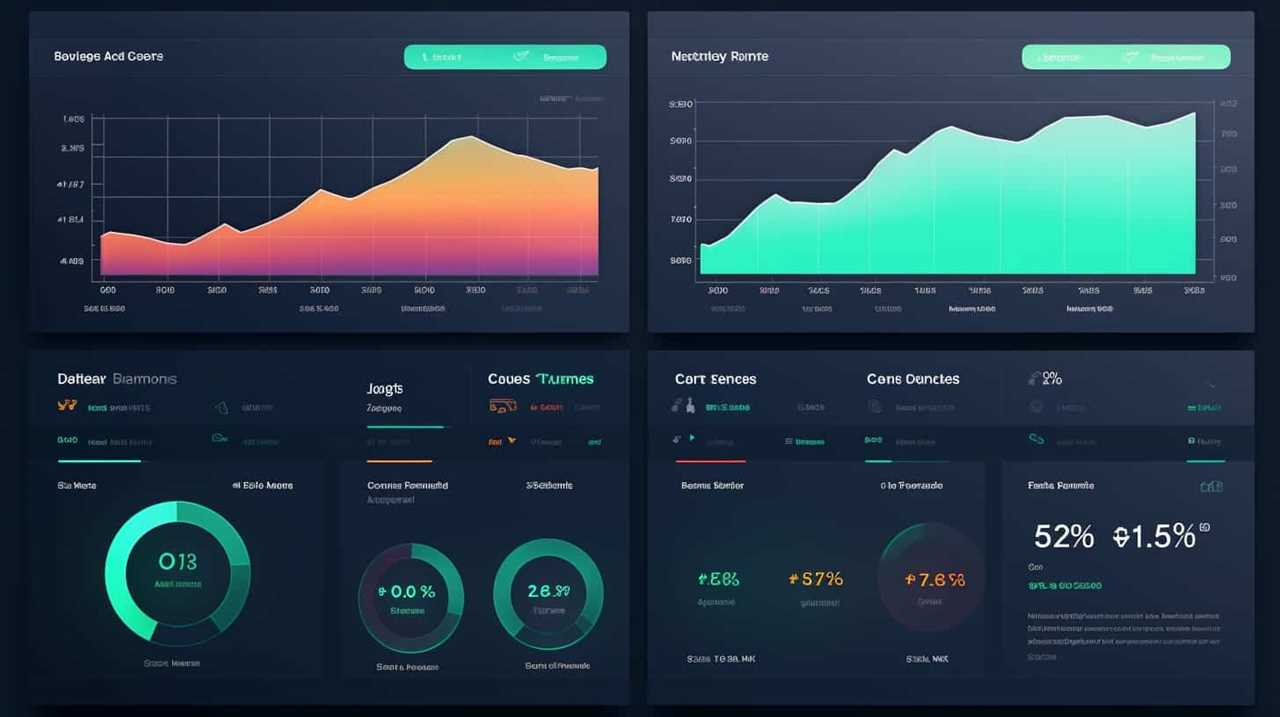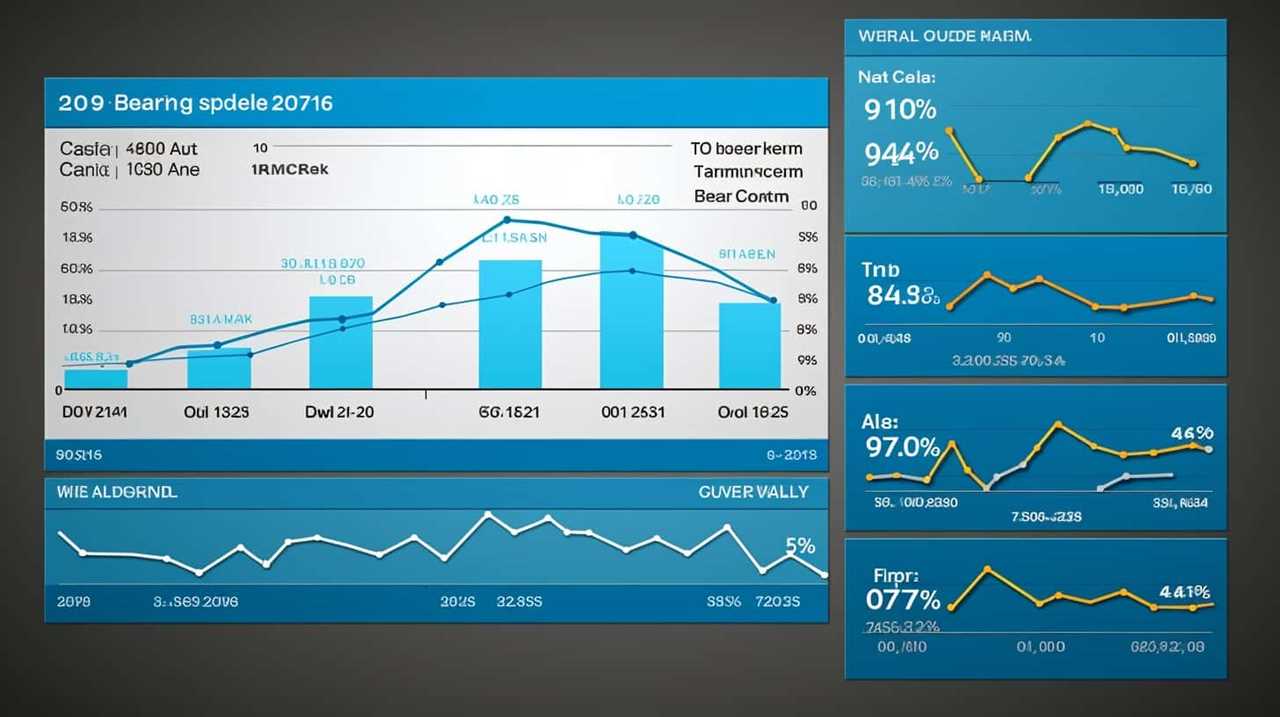Technical SEO
Consistent Content: 14 Tips to Strengthen Topical Authority

Tired of producing material that fails to exemplify your knowledge? Search no more! This article uncovers 14 tactics to amplify your credibility in your field and evolve you into an adept content creator.
From defining your target audience to collaborating with influencers, we’ve got you covered. Say goodbye to inconsistency and hello to a content strategy that will elevate your brand’s reputation.
Let’s dive in and become the authority in your niche!
Key Takeaways
- Thoroughly analyze and segment your target audience to tailor content to their specific needs and preferences.
- Conduct keyword research to enhance topical authority and increase search visibility.
- Develop a content strategy based on target audience analysis and preferences.
- Establish brand trust and reliability through consistent publishing and optimization of content for SEO.
Define Your Target Audience
To define our target audience, we must identify the specific demographic that our consistent content aims to engage. This involves conducting a thorough target audience analysis and audience segmentation. By understanding who our audience is, we can create content that resonates with their needs and desires.

Target audience analysis involves gathering data on demographics, such as age, gender, location, and interests, to gain insights into their preferences and behaviors. Audience segmentation allows us to divide our audience into distinct groups based on shared characteristics, enabling us to tailor our content to each segment’s specific needs.
Conduct Thorough Keyword Research
When it comes to strengthening our topical authority, conducting thorough keyword research is key. By effectively targeting the right keywords, we can enhance the relevance of our content to our target audience.
This not only increases our search visibility but also ensures that our content aligns with what our audience is searching for, ultimately driving more organic traffic to our website.
Effective Keyword Targeting
One key step in strengthening our topical authority is conducting thorough keyword research, utilizing a variety of tools and techniques.

Effective keyword research allows us to identify the most relevant and high-traffic keywords to target in our content.
By understanding what keywords our audience is searching for, we can optimize our webpage titles and ensure that our content aligns with their needs. This not only helps improve our search engine rankings but also increases the likelihood of attracting qualified traffic to our website.
When conducting keyword research, it’s important to consider factors such as search volume, keyword competitiveness, and relevance to our target audience.
Enhancing Topical Relevance
We enhance topical relevance by conducting thorough keyword research and utilizing a variety of tools and techniques. Targeting keywords is crucial for improving the visibility and ranking of our content. By understanding the search intent behind specific keywords, we can create content that aligns with what our audience is looking for.

To conduct effective keyword research, we employ various tools and techniques such as keyword research tools, competitor analysis, and user search data. These resources help us identify relevant keywords that have high search volume and low competition.
Once we have identified the target keywords, we focus on content optimization. This involves incorporating the keywords naturally into our content, including in the title, headings, and throughout the body. We also ensure that our content provides valuable and comprehensive information related to the keywords, further enhancing its topical relevance.
By conducting thorough keyword research and optimizing our content, we strengthen our topical authority and improve our chances of ranking higher in search engine results.
| Tools & Techniques | Benefits |
|---|---|
| Keyword research tools | Identify relevant keywords with high search volume |
| Competitor analysis | Understand the keywords used by competitors |
| User search data | Identify trending topics and search queries |
Incorporating these tools and techniques into our keyword research process allows us to stay ahead of the competition and provide our audience with the most relevant and valuable content.

Increasing Search Visibility
To consistently increase search visibility, we regularly conduct thorough keyword research using various tools and techniques.
By identifying the right keywords, we can optimize our content to improve search rankings and increase website traffic. Keyword research involves analyzing search volumes, competition, and relevance to our target audience.
We utilize tools like Google Keyword Planner, SEMrush, and Moz to gather data and insights on popular search terms related to our industry. This research helps us understand the language and terms our audience uses when searching for information.
By incorporating these keywords strategically into our content, we can enhance our visibility in search engine results pages and attract more organic traffic.

Conducting thorough keyword research is the first step in developing a content strategy that aligns with our audience’s needs and interests.
Develop a Content Strategy
When developing a content strategy, it’s essential to thoroughly research and understand your target audience’s needs and preferences. This involves conducting a comprehensive target audience analysis to gain valuable insights into their demographics, interests, and behaviors.
By understanding your audience, you can tailor your content to meet their specific needs and preferences, increasing engagement and driving traffic to your website.
Additionally, content optimization plays a crucial role in developing a successful strategy. Optimizing your content involves incorporating relevant keywords, creating high-quality and valuable content, and ensuring that it’s easily accessible and shareable.

Create a Content Calendar
Creating a content calendar is essential for planning and organizing our content in advance. By mapping out our topics and scheduling our publishing dates, we can ensure that our content remains relevant and maintains a consistent flow.
This allows us to stay on track with our goals and engage our audience with timely and valuable information.
Planning Content in Advance
By strategically mapping out our content in advance and creating a content calendar, we ensure a consistent and organized approach to publishing. Planning our content in advance allows us to stay focused and align our efforts with our overall goals. Here are three reasons why planning content in advance is crucial for a successful content strategy:
- Improved Efficiency: With a content calendar in place, we can allocate resources and time effectively, ensuring that each piece of content is well-researched and of high quality.
- Consistency: Planning ahead helps us maintain a consistent publishing schedule, which builds trust and loyalty with our audience.
- Better Content Organization: A content calendar helps us visualize the big picture and identify any gaps or overlaps in our content. This allows us to create a well-rounded and comprehensive content strategy.
Maintaining Topical Relevance
To ensure consistent topical relevance, we maintain a content calendar that guides our publishing schedule. This calendar serves as a strategic tool that helps us plan and organize our content creation process. By mapping out our topics and deadlines in advance, we can ensure that our content remains aligned with our targeting strategies and goals.

The content calendar allows us to identify gaps in our content and optimize our publishing schedule accordingly. It helps us stay on track and maintain a consistent flow of relevant content that resonates with our audience. By incorporating content optimization techniques into our calendar, we can further enhance our topical authority and ensure that our content remains valuable and informative.
With a well-maintained content calendar, we can guarantee that our publishing remains consistent and on schedule, which we’ll discuss further in the next section.
Consistency in Publishing
We maintain a content calendar to ensure consistent publishing and strengthen our topical authority. Consistency in publishing can be challenging, but the benefits are worth it. Here are three reasons why a content calendar is essential:
- Organization: A content calendar helps us plan and organize our content in advance. It ensures that we have a steady stream of high-quality articles, videos, or podcasts ready to publish regularly.
- Accountability: With a content calendar, we hold ourselves accountable to stick to a publishing schedule. This helps us avoid procrastination and ensures that our audience knows when to expect new content.
- Efficiency: By planning ahead, we can streamline our content creation process. We can allocate time and resources more efficiently, resulting in better quality content and less stress.
Consistent publishing establishes our brand as a reliable source of information and builds trust with our audience. It sets us apart from competitors and strengthens our topical authority.

Consistently Publish High-Quality Content
In order to establish and maintain a strong sense of topical authority, it is essential for us to consistently produce and deliver high-quality content. The content we create should not only be informative and engaging, but also demonstrate our expertise in the subject matter. To achieve this, we need to conduct thorough target audience analysis to understand the needs and interests of our readers. This will help us tailor our content to their preferences and provide them with valuable information. Additionally, having a well-defined content creation process in place ensures that our content is consistently of high quality. This process should include steps such as brainstorming ideas, conducting research, creating outlines, writing drafts, and editing. By following these guidelines, we can consistently publish content that strengthens our topical authority and resonates with our audience.
| Tips for Consistently Publishing High-Quality Content |
|---|
| 1. Conduct target audience analysis |
| 2. Develop a content creation process |
| 3. Brainstorm ideas |
| 4. Conduct thorough research |
| 5. Create outlines |
| 6. Write drafts |
| 7. Edit and proofread carefully |
| 8. Use visuals to enhance understanding |
| 9. Incorporate data and statistics |
| 10. Use credible and reliable sources |
Optimize Your Content for SEO
When it comes to optimizing our content for SEO, there are a few key points we need to consider.
First, conducting thorough keyword research is essential to ensure we’re targeting the right audience and increasing our visibility in search engine results.
Second, optimizing our meta tags, including title tags and meta descriptions, can greatly impact how our content appears in search results and entices users to click through.

Lastly, implementing effective link building strategies can help improve our website’s authority and credibility, ultimately boosting our SEO performance.
Keyword Research Importance
One important aspect of optimizing our content for SEO is understanding the significance of keyword research. By conducting thorough keyword research, we can identify the most relevant and popular search terms that our target audience uses. This allows us to tailor our content to meet their needs and improve our search engine rankings.
Here are some key points to consider when it comes to keyword research:
- Keyword research techniques: Utilize tools like Google Keyword Planner, SEMrush, or Moz Keyword Explorer to discover relevant keywords and analyze their search volume and competition.
- Importance of long tail keywords: Long tail keywords are more specific and have lower competition, making it easier for our content to rank higher in search results. They also attract more targeted traffic and have a higher chance of converting into leads or sales.
- Regularly update keyword research: Keep up with the latest trends and changes in search behavior to ensure our content remains optimized for SEO.
Meta Tags Optimization
To optimize our content for SEO, we should focus on meta tags optimization, which involves utilizing relevant keywords and providing concise and descriptive information about our content. Meta tags are snippets of HTML code that provide information to search engines about the content of a webpage. By optimizing these tags, we can improve our website’s visibility and increase organic traffic.

One important meta tag is the title tag, which appears as the clickable headline in search engine results. Including relevant keywords in the title tag helps search engines understand the topic of our content. Another crucial meta tag is the meta description, which provides a brief summary of our webpage’s content. By crafting a compelling and informative meta description, we can entice users to click on our link in search results.
Here is an example of how to optimize meta tags for a blog post about link building strategies:
| Meta Tag | Content |
|---|---|
| Title Tag | Effective Link Building Strategies |
| Meta Description | Learn proven strategies to build high-quality links and improve your website’s SEO performance. |
| Keywords | link building strategies, SEO, backlinks, organic traffic, search engine optimization |
Incorporating meta tags optimization into our SEO strategy is a simple yet powerful way to enhance our website’s visibility and attract more organic traffic. By utilizing relevant keywords and providing concise and descriptive information, we can improve our chances of ranking higher in search engine results.
Link Building Strategies
To improve our website’s visibility and attract more organic traffic, we optimize our content for SEO by implementing effective link building strategies. Link building is crucial for establishing authority and credibility in the online world.

Here are three essential link building techniques to consider:
- Guest blogging: By writing high-quality content for other reputable websites in your industry, you can earn valuable backlinks and expand your reach.
- Broken link building: Identify broken links on relevant websites and reach out to the site owners, offering them a replacement link to your own content.
- Outreach and relationship building: Build relationships with influencers and industry experts, who can help promote your content and provide backlinks.
To ensure the effectiveness of your link building efforts, conducting regular backlink analysis is essential. This analysis helps you identify the quality and relevance of the backlinks pointing to your site, allowing you to make necessary adjustments and improvements.
Incorporate Relevant Internal and External Links
Incorporating relevant internal and external links is essential for strengthening our topical authority. Link building techniques play a crucial role in enhancing our website’s credibility and visibility. By strategically linking to high-quality, authoritative sources, we can demonstrate our expertise and provide valuable resources to our audience.
Internal links help establish a logical website structure and improve user experience by guiding visitors to related content within our site. On the other hand, external links to reputable sources show that we’ve done our research and provide additional context to support our claims.

Moreover, incorporating social media promotion into our link building strategy can increase our content’s reach and engagement, further establishing our topical authority. By sharing our articles and linking back to them on social platforms, we can attract more visitors and potentially gain backlinks from other authoritative websites.
As we delve into the next section, let’s explore how the effective use of engaging headlines and subheadings can further strengthen our content.
Use Engaging Headlines and Subheadings
When it comes to creating content that stands out, catchy headlines are key. They grab the reader’s attention and entice them to click and read further.
Additionally, using subheadings effectively organizes the content, making it easier for readers to navigate and understand the main points.

Catchy Headlines Grab Attention
Engaging headlines and subheadings captivate readers and enhance their attention. When it comes to creating attention-grabbing titles, there are several headline writing techniques that can be employed:
- Use numbers: Numbers attract attention and offer a clear promise of what readers can expect from the content. For example, ‘5 Secrets to Boost Your Productivity.’
- Pose a question: Questions immediately engage readers and pique their curiosity. A headline like ‘Are You Making These Common Mistakes in Your Marketing Strategy?’ compels readers to find out if they’re indeed making those mistakes.
- Create a sense of urgency: By using words like ‘now’ or ‘today,’ you create a sense of urgency and prompt readers to take immediate action. For instance, ‘Discover the Must-Have Tools for Successful Entrepreneurs Today.’
Subheadings Organize Content Effectively
To effectively organize content, we utilize engaging headlines and subheadings to guide readers through the article.
By using clear and concise subheadings, we improve readability and make it easier for readers to navigate the information presented.
Subheadings act as signposts, allowing readers to quickly scan the content and find the specific information they’re looking for. They also help to break up long blocks of text and make the article more visually appealing.

When crafting engaging headlines and subheadings, we consider the keywords and main points of the article, ensuring that they accurately reflect the content that follows.
Engaging Headings Improve Readability
We believe that utilizing engaging headings and subheadings is crucial for improving engagement and guiding readers through the content. By incorporating effective headings, readers are more likely to be drawn into the article and stay engaged throughout.
Here are three readability techniques that can be achieved through the use of engaging headings and subheadings:
- Enhanced Readability: Engaging headings break up the text and make it easier for readers to scan and understand the main points of the article.
- Improved Navigation: Subheadings act as signposts, helping readers navigate through the content and find the information they’re looking for quickly.
- Increased Interest: Interesting and attention-grabbing headings capture readers’ attention and entice them to continue reading, improving overall engagement.
Utilizing engaging headings and subheadings not only improves readability but also keeps readers interested and engaged in the content. By implementing these techniques, you can enhance the overall reading experience for your audience.

Leverage Social Media for Content Promotion
By utilizing social media platforms, we can effectively promote our content and increase its visibility. Social media advertising allows us to reach a larger audience by targeting specific demographics and interests. By partnering with influencers in our industry, we can leverage their followers and credibility to amplify our message. This not only increases our reach but also establishes our authority in the field.
To further enhance our content promotion efforts, we can utilize the power of hashtags to increase discoverability and engage with our audience through comments and direct messages. Additionally, sharing our content in relevant online communities and groups can generate valuable discussions and feedback.
Social media is a powerful tool that, when used strategically, can significantly boost our content’s exposure and drive traffic to our website.
Transition: Now that we’ve explored the importance of leveraging social media for content promotion, let’s move on to the next section about encouraging user interaction and feedback.

Encourage User Interaction and Feedback
Continuing the discussion from the previous subtopic, let’s now explore how encouraging user interaction and feedback can strengthen our topical authority. User engagement plays a crucial role in establishing ourselves as industry experts and gaining credibility.
Here are three key ways to encourage user interaction and feedback:
- Foster a sense of community: Create a platform where users can engage with one another, share insights, and ask questions. This fosters a sense of belonging and encourages users to actively participate.
- Respond promptly and thoughtfully: Show your audience that their opinions matter by responding to their comments and feedback in a timely and meaningful manner. This demonstrates that you value their input and encourages further engagement.
- Analyze feedback to improve: Regularly analyze the feedback received from users to gain insights into their needs, preferences, and pain points. Use this information to refine your content strategy and provide more valuable and relevant information.
Monitor and Analyze Your Content Performance
To effectively strengthen our topical authority, it’s crucial to monitor and analyze the performance of our content. Content analysis and performance tracking provide valuable insights into how well our content is resonating with our audience and meeting our goals.
By regularly monitoring metrics such as page views, time on page, bounce rate, and social shares, we can identify patterns and trends that help us optimize our content strategy. Additionally, we can use tools like Google Analytics or social media analytics platforms to track the performance of specific pieces of content and compare them to others.

This data allows us to make data-driven decisions, refine our content strategy, and ensure that our efforts are aligned with our audience’s interests and needs. Ultimately, content analysis and performance tracking are essential for maintaining and strengthening our topical authority.
Stay Updated With Industry Trends and News
We stay updated with industry trends and news to ensure that our content remains relevant and authoritative. Staying informed about the latest developments in our industry allows us to provide our audience with valuable insights and up-to-date information.
Here are three reasons why staying updated with industry trends and news is crucial for effective content curation:
- Stay ahead of the competition: By staying on top of industry trends, we can identify emerging topics and create content that addresses them before our competitors do.
- Build credibility and trust: When we consistently provide our audience with accurate and timely information, we establish ourselves as a trusted source of industry knowledge.
- Enhance our content strategy: By understanding the latest trends, we can align our content strategy accordingly, ensuring that our content resonates with our audience and meets their needs.
Collaborate With Influencers and Thought Leaders
One effective strategy to strengthen our topical authority is by partnering with influential industry leaders. Collaborating with influencers and thought leaders can greatly enhance our credibility and expand our reach in the industry. By leveraging their expertise and reputation, we can tap into their existing audience and gain exposure to a wider network of potential customers.

Influencer marketing allows us to showcase our brand to a highly engaged audience who trust and value the opinions of these industry leaders. By collaborating with thought leaders, we can establish ourselves as a credible source of information and demonstrate our expertise in the field. This partnership not only helps us build trust with our target audience but also positions us as a go-to resource for industry insights.
To maximize the benefits of this collaboration, it’s crucial to choose influencers and thought leaders whose values align with our brand and target audience. By creating authentic and valuable content together, we can establish ourselves as thought leaders in our own right and strengthen our topical authority within the industry.
Continuously Improve and Adapt Your Content Strategy
Our content strategy should consistently evolve and adapt to stay relevant and effective in strengthening our topical authority. To continuously improve and adapt our content strategy, we must focus on improving engagement and optimizing our content. Here are three key steps to achieve this:
- Conduct regular content audits to identify areas of improvement and ensure our content aligns with our target audience’s needs and interests.
- Stay updated with the latest industry trends and changes in search algorithms to keep our content strategy up-to-date and effective.
- Leverage analytics and data to measure the performance of our content and make data-driven decisions for optimization.
Frequently Asked Questions
How Can I Identify My Target Audience?
To identify our target audience, we analyze demographics and understand their interests. This enables us to create content that resonates with them, building strong connections and establishing our authority in the topic.

What Are the Best Tools for Conducting Keyword Research?
When conducting keyword research, we find competitor analysis to be a valuable tool. It helps us identify what keywords our competitors are targeting and allows us to discover potential long tail keywords with lower competition.
How Do I Create a Content Strategy That Aligns With My Business Goals?
Creating a content strategy that aligns with our business goals begins with understanding our target audience and their needs. By consistently delivering valuable and relevant content, we can establish our expertise and authority in our industry.
What Should I Include in My Content Calendar?
When creating a content calendar, we should include a mix of engaging content that resonates with our audience. It’s important to implement SEO strategies to ensure our content is discoverable and drives traffic to our website.
How Can I Effectively Collaborate With Influencers and Thought Leaders?
To effectively collaborate with influencers and thought leaders, we prioritize building genuine relationships, aligning goals, and providing value. By leveraging influencer partnerships and thought leader collaborations, we amplify our brand’s reach and establish ourselves as industry authorities.

Conclusion
In conclusion, by consistently creating high-quality content, staying informed about industry trends, and collaborating with influencers, you can strengthen your topical authority and establish yourself as an expert in your field.
While it may seem challenging to consistently produce valuable content, the rewards are worth it. So don’t let the fear of not having enough time or resources hold you back.
Start implementing these tips today and watch your authority grow, inspiring trust and loyalty from your audience.
Technical SEO
What Will Happen to Seo With Ai

The continual contemplation of how artificial intelligence (AI) could revolutionize the SEO landscape has been a topic of interest. Now, the future is here, offering us a plethora of chances to embrace.
AI has the potential to transform the way we approach search engine optimization, from content creation to keyword research and user experience. With AI, we can unlock new levels of innovation and efficiency in our SEO strategies.
It’s a thrilling time to be in the SEO game, as we navigate the uncharted territory of an AI-dominated future. Let’s dive in and explore the liberating potential of SEO with AI.
Key Takeaways
- AI has transformed website optimization for search engines, providing advanced methods for improving visibility and ranking.
- AI-powered content creation revolutionizes information production, generating high-quality, engaging content at a faster rate.
- AI enhances keyword research by providing valuable insights into user searches and competitor strategies, leading to more effective keyword targeting.
- AI analyzes user behavior and preferences to deliver personalized results, improving the overall user experience while respecting privacy and complying with regulations.
The Role of AI in SEO
The use of AI in SEO has significantly transformed the way we optimize websites for search engines. With the advent of AI driven search algorithms and AI powered SEO tools, we now have access to more advanced and efficient methods for improving our website’s visibility and ranking.

These AI technologies utilize complex algorithms to analyze vast amounts of data, identifying patterns and trends that help us understand user behavior and search intent. This data-driven approach allows us to tailor our content and website structure to better align with what users are searching for.
AI-Powered Content Creation
Continuing our exploration of AI’s impact on SEO, let’s delve into the realm of AI-powered content creation.
Automated writing and AI-generated content are revolutionizing the way we produce and consume information. AI algorithms can now generate high-quality, engaging content that rivals human-written articles. This technology has the potential to liberate content creators from the time-consuming task of creating content from scratch.
With AI-powered tools, we can automate the writing process, allowing us to produce more content in less time. AI can analyze vast amounts of data and generate insightful, data-driven articles that appeal to our audience’s desire for innovative and analytical content.

As AI continues to advance, we can expect a future where AI-generated content becomes an integral part of the SEO landscape.
Enhancing Keyword Research With AI
To enhance our keyword research process, we can utilize AI technology. AI-driven search trends can provide valuable insights into what users are searching for, allowing us to optimize our content accordingly.
By analyzing vast amounts of data, AI can identify patterns and trends that humans may overlook, enabling us to stay ahead of the competition.
Additionally, AI-driven competitor analysis helps us understand our competitors’ keyword strategies, allowing us to identify opportunities and refine our own approach.

With AI’s ability to process and analyze data at a rapid pace, we can make data-driven decisions that lead to more effective keyword targeting and improved SEO performance.
AI’s Impact on User Experience and Rankings
One key impact of AI on user experience and rankings is its ability to analyze user behavior and preferences with precision. AI algorithms can collect and process vast amounts of data, allowing SEO professionals to gain valuable insights into user preferences, search patterns, and engagement metrics. This data-driven approach enables marketers to understand their audience better, tailor their content to meet their needs, and ultimately deliver a more personalized user experience.
However, as AI becomes more prevalent in SEO, there are ethical implications that need to be considered. Balancing personalization and privacy is crucial in AI-driven SEO. While AI can enhance user experience by providing personalized recommendations, it must be done in a way that respects user privacy and complies with data protection regulations.
In the next section, we’ll explore how SEO strategies need to adapt to thrive in an AI-dominated future and continue to deliver valuable content while ensuring ethical practices and user privacy are maintained.

Adapting SEO Strategies for an AI-dominated Future
As we delve into the realm of an AI-dominated future, our SEO strategies must adapt in order to thrive and deliver valuable content that aligns with evolving user preferences and behaviors.
To ensure success in this new landscape, we must consider ethical considerations in AI driven SEO. This involves promoting transparency and accountability in our algorithms, as well as ensuring that user privacy is respected.
Additionally, adapting SEO tactics for voice search and virtual assistants is crucial. With the rise of smart speakers and virtual assistants like Siri and Alexa, optimizing content for voice search queries and providing concise, conversational answers will be essential for maintaining relevance and visibility.
Frequently Asked Questions
How Does AI Technology Impact the Overall Efficiency and Effectiveness of SEO Strategies?
Ai technology revolutionizes SEO strategies, enhancing efficiency and effectiveness. By leveraging machine learning algorithms, search engines can analyze vast amounts of data, providing personalized search results. The future of SEO lies in harnessing the power of artificial intelligence.

How Can Ai-Powered Tools Assist in Optimizing Website Content for Search Engines?
Can AI-powered tools optimize website content for search engines? AI-driven keyword research and content recommendations provide data-driven, innovative solutions to improve SEO efficiency, effectiveness, and liberation from traditional strategies.
What Potential Risks or Challenges Does AI Pose for Traditional SEO Practices?
Potential implications and limitations of AI in SEO include the risk of overreliance on automated tools, decreased human creativity, and potential biases in algorithmic decision-making. These challenges require innovative solutions to ensure the liberation of traditional SEO practices.
Can AI Algorithms Effectively Predict and Adapt to Changes in Search Engine Algorithms?
AI algorithms have the potential to revolutionize SEO by effectively predicting and adapting to changes in search engine algorithms. This could have a significant impact on website rankings and shape the future of SEO with artificial intelligence.
Are There Any Ethical Considerations or Concerns Associated With Using AI in SEO Practices?
There are ethical implications and bias concerns associated with using AI in SEO practices. We need to consider how AI algorithms can potentially perpetuate biases and ensure that AI is used responsibly and with transparency.

Conclusion
In conclusion, the integration of AI in SEO is revolutionizing the way we approach digital marketing. By leveraging AI-powered content creation and enhancing keyword research, businesses can stay ahead in the competitive online landscape.
Furthermore, AI’s impact on user experience and rankings allows for personalized and relevant search results.
As we adapt our SEO strategies for an AI-dominated future, we can expect to see even more innovative and data-driven approaches to drive organic traffic and improve website visibility.
Technical SEO
On-Page Seo Factors

Are you ready to master the skills of on-page SEO techniques?
In this article, we’ll uncover the secrets to boosting your website’s visibility and driving organic traffic.
From keyword research to optimizing meta tags, crafting compelling page titles, and enhancing user experience with internal linking, we’ll guide you through the best practices for optimizing your website’s on-page factors.
Get ready to take your SEO game to the next level and unlock the full potential of your website.

Let’s dive in!
Key Takeaways
- Keyword research and optimization are crucial for effective on-page SEO.
- Optimizing meta tags and page titles increases visibility in search engine results pages (SERPs).
- Internal linking improves website navigation and enhances user experience.
- Simple and understandable URL structure with relevant keywords enhances SEO value.
Importance of Keyword Research
Keyword research is an essential step in our SEO strategy as it helps us identify the most effective keywords to target for optimal on-page optimization. By conducting thorough keyword research, we can uncover long tail keywords that are highly relevant to our niche audience.
These long tail keywords are specific and targeted, making it easier for us to attract the right kind of traffic to our website.
Additionally, competitor analysis plays a crucial role in our keyword research process. By analyzing our competitors’ keyword strategies, we can gain valuable insights into the keywords they’re targeting and leverage that information to refine our own keyword selection.

This allows us to stay ahead of the competition and ensure that our on-page optimization efforts are aligned with the latest industry trends.
Optimizing Meta Tags for SEO
Moving on from the importance of keyword research, we now focus on optimizing meta tags for SEO. Meta tags provide information about a webpage to search engines and visitors. By optimizing meta tags, we can enhance the visibility and relevance of our webpages in search engine results. Below is a table summarizing the key meta tag optimization techniques and the SEO impact of meta tag keywords:
| Meta Tag Optimization Techniques | SEO Impact of Meta Tag Keywords |
|---|---|
| Use unique and descriptive tags | Improve search engine rankings |
| Include relevant keywords | Increase visibility in SERPs |
| Write compelling meta descriptions | Increase click-through rates |
Crafting Engaging and Relevant Page Titles
Crafting engaging and relevant page titles is an essential aspect of optimizing on-page SEO. Creating compelling headlines is crucial because they’re the first thing that users see when searching for information online.
A well-crafted title not only grabs the reader’s attention but also provides a clear indication of what the page is about. Including relevant keywords in the title helps search engines understand the content and rank it appropriately in search results.

By incorporating keywords that accurately reflect the page’s content, you increase the chances of attracting the right audience and driving organic traffic to your site.
Enhancing User Experience With Internal Linking
To enhance user experience, we can improve website navigation and content discoverability through the strategic use of internal linking. By incorporating internal links within our website, we can guide users to relevant pages and allow them to easily explore related content.
Here are three ways to enhance user experience through internal linking:
- Improving website navigation:
Internal links can be used to create a clear and logical site structure, making it easier for users to navigate through different sections of the website. - Utilizing anchor text effectively:
When creating internal links, it’s important to use descriptive and keyword-rich anchor text. This helps users understand what to expect when they click on a link and also provides search engines with valuable context. - Increasing content discoverability:
Internal linking can also be used to highlight important or related content within our website. By linking to relevant pages, we can encourage users to explore more of our content and increase their engagement.
By implementing these strategies, we can enhance user experience and improve the overall usability of our website.

Now, let’s move on to discuss best practices for URL structure.
Best Practices for URL Structure
Now, let’s explore three best practices for optimizing the URL structure of our website to improve its search engine optimization (SEO) performance.
URL optimization techniques play a crucial role in determining search rankings.
Firstly, it’s important to keep the URL structure simple and easy to understand. This helps search engines and users alike to navigate the website more efficiently.

Secondly, including relevant keywords in the URL can further enhance its SEO value. This provides search engines with valuable information about the content of the page.
Lastly, it’s recommended to use hyphens to separate words in the URL, as opposed to underscores or spaces. Hyphens improve readability and ensure that search engines can correctly interpret the URL.
Frequently Asked Questions
How Does Website Speed Affect On-Page Seo?
Website speed significantly impacts on-page SEO. Slow loading times can negatively impact user experience, leading to higher bounce rates and lower search engine rankings.
Additionally, with the increasing importance of mobile optimization for on-page SEO, fast loading times are crucial. Mobile users expect quick access to information, and if a website is slow, they’re likely to abandon it.

Therefore, optimizing website speed is essential for improving on-page SEO and providing a positive user experience.
What Are Some Common Mistakes to Avoid When Optimizing Meta Tags for Seo?
When optimizing meta tags for SEO, it’s important to be aware of common pitfalls and best practices. We should avoid making mistakes that could negatively impact our website’s ranking.
By focusing on keyword relevance, avoiding duplicate content, and using descriptive titles and meta descriptions, we can improve our on-page SEO.
It’s crucial to remember that meta tags play a significant role in search engine optimization, so taking the time to optimize them correctly is essential for success.

Is It Necessary to Include Keywords in Every Page Title for Effective On-Page Seo?
Including keywords in every page title isn’t necessary for effective on-page SEO. While it’s important to include relevant keywords in page titles, the focus should also be on creating titles that accurately describe the content and provide a good user experience.
Balancing keyword optimization with user-centricity is key. By considering the role of user experience in optimizing on-page SEO, we can create titles that attract both search engines and users, resulting in better rankings and increased traffic.
How Can Internal Linking Help Improve Search Engine Rankings?
Internal linking can greatly enhance search engine rankings. By optimizing anchor text, we can signal to search engines the relevance and authority of the linked page. This helps search engines understand the context and subject matter of the linked content, ultimately improving its visibility in search results.
Internal linking also allows for the distribution of link equity throughout a website, boosting the authority and visibility of all pages.

Are There Any Specific Guidelines to Follow When Creating URL Structures for Better On-Page Seo?
When it comes to creating URL structures for better on-page SEO, there are specific guidelines that we should follow. User-friendly URLs are crucial for improving search engine rankings.
By incorporating URL structure best practices, we can make our webpages more accessible and easier to navigate for both users and search engines. This not only helps with SEO but also enhances the overall user experience.
Conclusion
In conclusion, focusing on on-page SEO factors is crucial for improving website visibility and attracting organic traffic.
By conducting thorough keyword research, optimizing meta tags, crafting engaging page titles, enhancing user experience through internal linking, and following best practices for URL structure, you can ensure that your website is easily discoverable by search engines and provides a seamless browsing experience for your visitors.

Remember, as the adage goes, ‘A stitch in time saves nine’ – investing time and effort in on-page SEO now will yield long-term benefits for your website’s success.
Technical SEO
3 Winning On-Page SEO Tactics for Local Businesses

Ready to take your local business to the next level? Look no further!
In this article, we will reveal three winning on-page SEO tactics that will skyrocket your online presence. With our expert guidance, you’ll learn how to:
- Conduct keyword research and optimization
- Create localized content
- Optimize your website technically
These strategies will drive targeted traffic to your site, increase your visibility, and ultimately help you dominate the local market.
Let’s dive in and unlock the secrets to SEO success!

Key Takeaways
- Implementing on-page SEO tactics attracts targeted traffic to local business websites.
- Localized content creation resonates with the local audience and builds trust.
- Website technical optimization enhances user experience and search engine rankings.
- Thorough keyword research and optimization strategies ensure visibility for local businesses.
Keyword Research and Optimization
In our quest for higher search rankings, we rely on thorough keyword research and optimization techniques to ensure our local businesses get the visibility they deserve. One of the key strategies we employ is long tail keyword targeting. By focusing on longer and more specific keyword phrases, we can better match the search intent of our target audience. This allows us to attract highly relevant traffic to our websites and increase the chances of conversion.
In addition to long tail keyword targeting, we also conduct competitor analysis. This involves studying the keywords that our competitors are ranking for and identifying any gaps or opportunities in their strategies. By understanding what keywords our competitors are targeting, we can make informed decisions on how to differentiate ourselves and create a competitive advantage in the search results.
Localized Content Creation
To effectively boost local businesses’ search rankings, we prioritize creating localized content. This involves tailoring our content to resonate with our geo targeted audience and engage them on a deeper level.
Here are some key tactics we employ in our localized content creation strategy:

- Conducting thorough market research to understand the preferences and needs of our local audience.
- Creating location-specific landing pages that provide relevant and valuable information about our products or services.
- Incorporating local keywords and phrases into our website content to improve search visibility.
- Developing a multilingual content strategy to cater to diverse communities and expand our reach.
- Utilizing user-generated content and testimonials to build trust and credibility within the local community.
By implementing these strategies, we ensure that our content resonates with our local audience and enhances their overall experience.
In the next section, we’ll delve into website technical optimization to further optimize our local business’s online presence.
Website Technical Optimization
To optimize our local business’s online presence, we implement website technical optimization strategies. Two key components of this are website speed optimization and mobile-friendly design.
Website speed optimization involves improving the loading time of our website to ensure a seamless user experience. This can be done by optimizing images, minimizing code, and using caching techniques. A fast-loading website not only improves user experience but also contributes to better search engine rankings.

Additionally, we prioritize mobile-friendly design to cater to the increasing number of users accessing websites on mobile devices. This involves creating responsive designs that adapt to different screen sizes and ensuring that all website features are accessible on mobile.
Frequently Asked Questions
How Can I Track the Performance of My Keywords After Optimizing Them for My Local Business?
After optimizing our keywords for our local business, we can track their performance to gauge the success of our local SEO strategy. By monitoring keyword rankings and analyzing website analytics, we can measure the effectiveness of our optimization efforts.
Are There Any Specific Guidelines to Follow When Creating Localized Content for Different Regions?
When it comes to creating localized content for different regions, there are important guidelines to follow. These best practices for local SEO optimization will ensure that your content resonates with your target audience and boosts your visibility in search results.
Should I Focus on Optimizing My Website for Mobile Devices as Well, Even if My Business Is Primarily Local?
We should focus on optimizing our website for mobile devices, even if our business is primarily local. Mobile friendly websites are important for local businesses because they provide a better user experience and can lead to higher conversion rates. Additionally, responsive web design offers numerous benefits for local businesses.

What Are Some Common Technical Issues That Could Be Affecting My Website’s Performance in Search Results?
Common technical issues can greatly impact a website’s search performance. To troubleshoot, focus on factors like slow loading speed, broken links, duplicate content, and improper URL structures. Implementing fixes can significantly improve your site’s visibility.
Is It Necessary to Regularly Update and Refresh the Localized Content on My Website for Better SEO Results?
Regularly updating and refreshing localized content on our website is essential for better SEO results. It’s like adding fuel to a fire, boosting our visibility in local search results. Incorporating local reviews and user-generated content enhances our website’s content strategy and improves local SEO performance.
Conclusion
In conclusion, by implementing these winning on-page SEO tactics, local businesses can soar to new heights in the digital landscape.
Like a skilled painter adding vibrant strokes to a canvas, keyword research and optimization, localized content creation, and website technical optimization work together to create a masterpiece of online visibility.

With a strategic approach and attention to detail, businesses can captivate their audience and stand out amidst the sea of competitors.
So, let’s paint a picture of success and watch as our business blooms.
-

 Expert Content Authority4 weeks ago
Expert Content Authority4 weeks agoThe Pillar of SEO: Why Content Consistency Matters Most
-

 Learning Center4 weeks ago
Learning Center4 weeks agoUncover How To Use ChatGPT to Write Effective Ad Copy
-

 Learning Center3 weeks ago
Learning Center3 weeks agoAI in 2024: 10 Things We are NOT Looking Forward To
-

 Holistic SEO4 days ago
Holistic SEO4 days agoHolistic Local SEO Tactics for Small Businesses
-

 Learning Center4 weeks ago
Learning Center4 weeks agoOptimize Your Digital Experience with Akamai CDN
-

 Learning Center3 days ago
Learning Center3 days agoExperience How GPT-4 Turbo Beats Claude 2: A Review
-

 Learning Center3 days ago
Learning Center3 days agoMastering SEO through the Google SGE Lens: A Comprehensive Guide
-

 Holistic SEO3 days ago
Holistic SEO3 days agoHow to Establish Dominance in SEO through Topical Authority
















